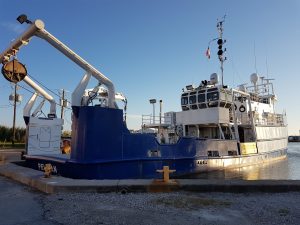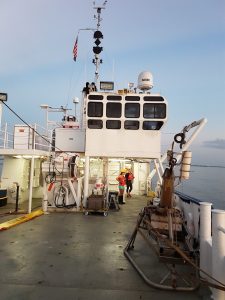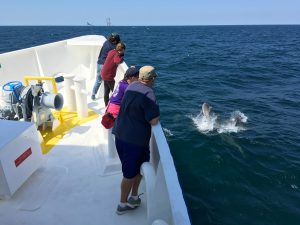Coastal oceanography in the height of hurricane season
Written By: Mallory Ringham

The R/V Pelican awaiting our departure.
Oceanographic research cruises are typically planned months, if not years, in advance of sailing. So we often have to view cruise itineraries as suggestions rather than as definite plans, with an understanding that weather and equipment status may significantly impact scientific goals. On September 8, the CO2 Systems Laboratory from Woods Hole Oceanographic Institution, together with collaborators from Texas A&M and the Hebrew University of Jerusalem, set sail into the Gulf of Mexico right in the middle of hurricane season. More specifically, right in the middle of two major hurricanes: Hurricane Harvey (August 25 – September 3), roaring through the western edge of the Gulf, and Hurricane Irma (August 30 – September 16), blowing in from the east. If that wasn’t enough, we also had bonus Hurricane Jose following in Irma’s wake.
The goal of our cruise, led by Eyal Wurgaft, Aleck Wang, James Churchill, and Timothy Della Penna, was to collect seawater and sediment samples for calcium carbonate (CaCO3) precipitation experiments in the northern Gulf of Mexico. Organisms that build shells make them out of CaCO3. However, CaCO3 can also form without the help of organisms, through inorganic precipitation – chemical reactions that suspend CaCO3 solids in the water column. This has been observed in the Red Sea and the Gulf of Aqaba. This inorganic pathway for CaCO3 precipitation is typically inhibited by other chemicals in seawater, including dissolved organic carbon, but in certain conditions may become important in the marine carbon cycle. Since study of the carbon cycle is important to our understanding of marine chemistry, as well as to studies of climate change and ocean acidification, it is important to determine the extent of this process in coastal regions where suspended dust and river sediments may provide a surface for these chemical precipitation processes to begin. For these reasons, our cruise targeted rivers in the northern Gulf of Mexico (Mississippi, Sabine, Atchafalaya, and Brazos), where we could collect seawater and sediment samples for further carbonate precipitation experiments.

On the deck of the R/V Pelican waiting for our instruments.
Our ship, the R/V Pelican, is a 116 ft former Army vessel based at the Louisiana Universities Marine Consortium (LUMCON) dock in Cocodrie, LA. Her shallow draft allows for operation within the rivers and marshes of the Gulf coast, but makes for a bumpy ride in high winds and swells, and we had plenty of those due to the distant storm activity. Our cruise plan was to sail into the mouth of the Mississippi to begin on-board experiments, then to sail west towards Galveston Bay for an ~8 day cruise. Hurricane Harvey thwarted this plan by damaging our trawling equipment housed at the Texas A&M University dock. Several members of our team will return to the Gulf another time to complete that objective. No matter, we adjusted our cruise track and re-ordered our station sampling, sailing west to the Brazos river while we waited for large storm swells at the mouth of the Mississippi to calm down enough for us to safely operate. Our main tools are a CTD Rosette water sampler (a collection of water collection tubes) and an apparatus known as a box corer that collects sediments. At-sea precipitation experiments in the Pelican’s wet lab had to be postponed until we could bring our samples home to Woods Hole. However, despite the changes made to our cruise plan in response to the season’s hurricanes, we were lucky to be operating around the storms and were able to complete our full suite of coastal and river sampling.

Dolphins escort us into our sampling sites.
Life at sea on the Pelican revolves around 24/7 scientific operations, with the science team split into two 12-hr shifts, midnight to noon and noon to midnight. On any given shift, we would steam towards our sampling site and deploy a CTD Rosette to collect water samples at various water depths. The CTD provides critical physical data, including temperature, salinity, and fluorescence. We also collected water samples to measure DIC (dissolved inorganic carbon), alkalinity, pH, major ions, nutrients, and suspended sample analysis. At shallow sites, the Texas A&M group used a box corer to collect short columns of sediment that can be sectioned, frozen, and later analyzed to see how the chemical and biological properties change through the different layers. Throughout the cruise, our underway pCO2 system provided important surface carbon chemistry data along our cruise track, and satellite data allowed us to look for plumes of sediment at the mouth of each river, from which we could identify the best sampling sites for our objectives. Outside of the scientific operations, the most popular at-sea recreational activity on the Pelican is almost certainly sight-seeing. Each shift is awake for either sunrise or sunset, and the Gulf of Mexico is full of dolphins, pelicans, and other sea life to watch while sailing between sampling sites.
Despite the challenges offered by the weather, we had a successful cruise and are excited to see the results of our sample analysis in the lab!